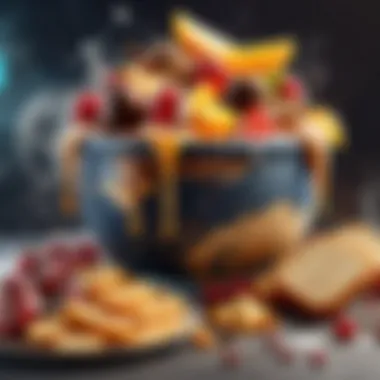Unveiling the Mastery of Blast Chilling in Artful Culinary Techniques


In the realm of culinary arts, the technique of blast chilling stands out as a remarkable innovation that revolutionizes the preservation of food quality. This method involves the rapid cooling of prepared dishes to maintain their freshness, flavors, and textures. Originally developed for commercial kitchens, blast chilling has now found its way into home cooking, allowing aspiring chefs to elevate their culinary creations to a professional standard.
Benefits of Blast Chilling
One of the key advantages of blast chilling is its ability to significantly reduce the bacterial growth in food. By swiftly lowering the temperature of hot dishes, the risk of contamination is minimized, ensuring food safety standards are met. Additionally, this process helps to lock in the natural flavors and nutrients of the ingredients, enhancing the overall taste and quality of the food. Blast chilling also extends the shelf life of prepared dishes, enabling efficient meal planning for both households and restaurants.
Equipment Used in Blast Chilling
Central to the practice of blast chilling are specialized appliances known as blast chillers. These machines are specially designed to quickly reduce the temperature of food, typically utilizing powerful fans and refrigeration systems to achieve rapid cooling. Available in a range of sizes to accommodate varying quantities of food, blast chillers are a valuable asset in commercial kitchens, bakeries, and food production facilities. Their precise temperature control and rapid cooling capabilities make them indispensable for preserving the integrity of freshly prepared dishes.
Best Practices for Blast Chilling
To optimize the benefits of blast chilling, it is essential to follow best practices that ensure food safety and quality. Proper food handling procedures must be observed to prevent cross-contamination during the chilling process. It is recommended to divide large batches of food into smaller portions before blast chilling to expedite cooling and maintain consistency. Additionally, labeling and dating containers help in monitoring the freshness of chilled dishes and controlling inventory in professional kitchen settings. By adhering to these guidelines, chefs and food enthusiasts can harness the full potential of blast chilling to elevate their culinary endeavors.
Introduction to Blast Chilling
In the realm of culinary practices, the concept of blast chilling holds a pivotal role, revolutionizing the way food preservation is approached. This section aims to delve deep into the significance of blast chilling within the culinary domain, shedding light on its essential processes, benefits, and considerations. As we navigate through this article, you will uncover a comprehensive understanding of the art of blast chilling and its profound impact on food quality maintenance and safety.
Understanding the Concept
Definition of Blast Chilling
Embarking on the definition of blast chilling, we encounter a technique that involves the rapid cooling of food to preserve its freshness and texture. This method stands as a monumental choice in the culinary world due to its ability to retain the natural flavors and nutritional value of dishes effectively. The unique feature of blast chilling lies in its capability to bring down the temperature of food rapidly, inhibiting microbial growth and ensuring food safety standards are met impeccably. Through the utilization of blast chilling, culinary experts can maintain the integrity of their culinary creations with precision and excellence.
Principles of Rapid Cooling
The principles underpinning rapid cooling mechanisms are fundamental in understanding the essence of blast chilling. By focusing on the rapid reduction of food temperature, the principles of rapid cooling play a crucial role in upholding food quality and safety. This approach is widely favored in culinary practices due to its efficiency in minimizing bacterial contamination and promoting adherence to stringent health standards. The unique feature of rapid cooling principles lies in their ability to prolong the shelf life of perishable items while upholding the freshness and taste of dishes. However, like any culinary technique, there exist considerations regarding optimal implementation to maximize the advantages and mitigate potential drawbacks effectively.
Historical Evolution
Origins of Blast Chilling
Tracing back to its origins, blast chilling finds its roots in the pursuit of extending the longevity of food products while maintaining their sensory attributes. The key characteristic of the origins of blast chilling lies in the innovative approach of using cold temperatures to preserve food, a practice that has transcended time and emerged as a cornerstone in modern culinary processes. This historical evolution showcases the adaptability and ingenuity of culinary professionals in safeguarding food quality and elevating the culinary experience to unprecedented heights.
Evolution in Modern Culinary Practices
The evolution of blast chilling within modern culinary practices signifies a profound shift towards enhancing efficiency and sustainability in food preparation. By embracing technological advancements and innovative methods, culinary artisans have redefined the standards of food preservation and safety. The key characteristic of this evolution lies in its seamless integration into diverse culinary settings, catering to the evolving needs of the industry and ensuring food remains at its peak quality. The unique feature of modern blast chilling practices lies in their versatility and adaptability, offering a spectrum of advantages while addressing challenges inherent to traditional cooling methods.
Benefits of Blast Chilling
Preservation of Flavor and Texture
In the realm of culinary arts, the significance of blast chilling cannot be overstated. It is a meticulous process that plays a vital role in preserving the quality and integrity of food, ensuring that flavors and textures remain optimal for longer periods. The use of this technique extends beyond mere cooling; it is a sophisticated method that enhances the overall dining experience by maintaining the sensory aspects of dishes. By rapidly reducing the temperature of cooked food, blast chilling effectively halts the cooking process, locking in flavors and textures at their peak state.


Retaining Nutritional Value
When delving into the essence of retaining nutritional value through blast chilling, one uncovers a fundamental aspect crucial for maintaining the health benefits of food. This retention of nutrients and vitamins is pivotal for consumers seeking not only delicious meals but also those that contribute to their well-being. The unique characteristic of blast chilling in preserving nutritional content lies in its ability to slow down the degradation of nutrients that typically occurs during conventional cooling methods. This feature ensures that the food served maintains its wholesome properties, offering a healthier dining option for individuals conscious of their dietary intake.
Minimizing Microbial Growth
Another key aspect of blast chilling is its efficacy in minimizing microbial growth, a critical consideration for food safety and hygiene in culinary practice. By swiftly reducing the temperature of cooked dishes, blast chilling creates an environment where bacteria and pathogens struggle to thrive. This feature is particularly advantageous in environments where food is prepared in advance or stored for extended periods, as it significantly reduces the risk of foodborne illnesses. The unique feature of inhibiting microbial growth through blast chilling offers a proactive approach to ensuring the safety and integrity of prepared meals, aligning with the highest standards of culinary excellence.
Enhanced Food Safety
With a primary focus on food safety, blast chilling stands out as a reliable tool in safeguarding consumers against potential health hazards. Its role in preventing bacterial contamination cannot be overlooked, particularly when considering the rapid proliferation of harmful bacteria in improperly cooled food. By promptly chilling dishes post-cooking, the risk of bacterial contamination is significantly reduced, providing a layer of protection for both chefs and diners alike.
Preventing Bacterial Contamination
The prevention of bacterial contamination through blast chilling is a game-changer in culinary settings, where adherence to stringent food safety practices is paramount. By effectively lowering the temperature of hot food items, blast chilling minimizes the window of opportunity for bacteria to reproduce and thrive. This feature not only upholds the quality and freshness of dishes but also upholds the reputation of establishments committed to maintaining impeccable hygiene standards.
Compliance with Health Standards
Furthermore, compliance with health standards is a key consideration in the realm of food service, where regulations dictate strict protocols to ensure public health and safety. Blast chilling's role in aligning with these standards underscores its importance in professional kitchens and catering facilities. By adopting blast chilling practices, culinary establishments demonstrate their commitment to upholding health and sanitation requirements, thereby mitigating risks associated with foodborne illnesses and cross-contamination.
Equipment Used in Blast Chilling
In the realm of culinary science, the equipment utilized plays a pivotal role in ensuring the efficacy and precision required for blast chilling. Understanding the nuances of the equipment used in blast chilling is essential for practitioners and enthusiasts aiming to master this delicate process. The selection of appropriate equipment can significantly impact the outcome and quality of blast chilling results. Efficient equipment not only enhances productivity but also contributes to maintaining the integrity of the food being chilled.
Blast Chillers
Types of Blast Chillers
When delving into the realm of blast chilling, one encounters various types of blast chillers available on the market. Each type possesses distinct features and functionalities that cater to specific culinary requirements. The classification of blast chillers may vary based on cooling capacity, size, or specialized functions. This diversity allows chefs and food service professionals to select a blast chiller tailored to their unique needs. From reach-in to roll-in models, each type offers a different set of advantages and considerations, influencing the selection process significantly.
Features and Functions
The features and functions of blast chillers epitomize the core capabilities that facilitate rapid and uniform cooling of food products. These elements are designed to maximize efficiency while maintaining optimal food safety standards. Key features include precise temperature controls, adjustable chilling cycles, and airflow management systems. Such functionalities ensure that food is cooled at the recommended rates, minimizing the risk of bacterial contamination and preserving food quality. While these features enhance operational convenience, they also demand careful consideration to harness their full potential effectively.
Accessories and Tools
Temperature Probes
Temperature probes are indispensable tools that aid in monitoring and regulating the chilling process with accuracy. By providing real-time temperature updates, chefs can ensure that food reaches the desired cooling threshold swiftly and uniformly. The usage of temperature probes mitigates the risk of uneven cooling, ensuring that every part of the food product receives consistent chilling treatment. However, the selection of temperature probes should align with the specific requirements of the blast chiller used to optimize their functionality.
Blast Chilling Pans
A crucial component in blast chilling, pans serve as vessels for holding food items during the chilling process. These specialized pans are designed to promote efficient heat transfer, expediting the cooling rate of food products placed within them. The material composition and surface finish of blast chilling pans can influence the speed and effectiveness of the chilling process. Choosing the appropriate pan size and type is essential for maximizing the chilling capacity of the blast chiller and ensuring uniform cooling across all food items.


Best Practices for Blast Chilling
Blast chilling in culinary practice requires adherence to best practices to ensure optimal results. These practices are fundamental in maintaining food quality, safety, and efficiency in commercial kitchens. By following specific elements such as proper food placement and setting ideal temperatures, chefs can enhance the benefits of blast chilling. When considering best practices for blast chilling, factors like food safety, preservation of flavors, and adherence to health standards play a crucial role.
Optimal Cooling Techniques
Proper Food Placement
Proper food placement is a critical aspect of blast chilling in culinary practice. It involves arranging food items strategically within the chilling equipment to facilitate even and rapid cooling. The key characteristic of proper food placement lies in maximizing airflow around the food, ensuring uniform cooling. By placing food items correctly in blast chillers, chefs can prevent hot spots and promote consistent chilling, preserving the quality and integrity of the food. The unique feature of proper food placement is its ability to prevent bacterial growth by facilitating uniform cooling, making it a popular choice for maintaining food safety in blast chilling processes.
Setting Ideal Temperatures
The process of blast chilling hinges on setting ideal temperatures to expedite the cooling process effectively. Choosing the right temperature for blast chilling is paramount to retain the freshness and texture of food items. By setting ideal temperatures specific to the type of food being chilled, chefs can achieve the desired results without compromising on quality. The key characteristic of setting ideal temperatures is to balance rapid cooling with safe temperature ranges to prevent microbial growth and maintain food safety. The unique feature of setting ideal temperatures lies in its ability to preserve the nutritional value of foods while extending their shelf life, making it a beneficial choice for optimizing blast chilling outcomes.
Timelines and Guidelines
Recommended Cooling Times
Recommended cooling times provide essential guidance for chefs engaging in blast chilling practices. These times vary depending on the type of food and equipment used, aiming to achieve the ideal temperature swiftly while maintaining food quality. The key characteristic of recommended cooling times is precision, ensuring that food reaches safe storage temperatures promptly to prevent bacterial contamination and degradation. By following recommended cooling times meticulously, chefs can uphold food safety standards and preserve the sensory attributes of dishes effectively. The unique feature of recommended cooling times is their role in minimizing nutrient loss and sustaining food freshness, making them a popular choice for culinary professionals striving for excellence.
Safe Thawing Practices
Safe thawing practices are equally important in blast chilling procedures, as they contribute to food safety and quality. Thawing food items correctly after blast chilling helps maintain texture and taste while preventing potential health risks. The key characteristic of safe thawing practices is gradual thawing at controlled temperatures to avoid bacterial growth and ensure even reheating. By adopting safe thawing practices, chefs can safeguard the integrity of ingredients and dishes, delivering optimal culinary experiences to customers. The unique feature of safe thawing practices is their ability to prevent foodborne illnesses and preserve the original quality of foods, making them a beneficial choice in the post-blast chilling process.
Innovations and Trends in Blast Chilling
In the culinary realm, staying ahead of the curve is paramount. The section on Innovations and Trends in Blast Chilling within this article digs deep into the evolution of blast chilling techniques, emphasizing the importance of embracing new technologies and practices to enhance food safety and quality. As culinary enthusiasts and professionals seek to push boundaries, understanding the significance of innovation in blast chilling becomes crucial for elevating standards across the industry.
Integration of Technology
Automated Blast Chilling Systems
Automated Blast Chilling Systems are revolutionizing the culinary landscape by streamlining and enhancing the blast chilling process. These systems offer precise control over cooling rates and temperatures, ensuring optimal preservation of food quality. The key characteristic of Automated Blast Chilling Systems lies in their ability to automate cooling cycles, reducing human error and expediting chilling processes. This automation not only improves efficiency but also allows for consistency in cooling, which is a fundamental aspect of maintaining food safety and quality. Additionally, the unique feature of Automated Blast Chilling Systems is their intuitive operation interface, making them user-friendly and accessible for chefs of varying expertise levels.
Smart Monitoring Solutions
Smart Monitoring Solutions play a pivotal role in ensuring the effectiveness and reliability of blast chilling procedures. By leveraging cutting-edge technology, these solutions provide real-time monitoring of temperatures, humidity levels, and other critical parameters during the chilling process. The key characteristic of Smart Monitoring Solutions is their ability to offer remote monitoring capabilities, enabling chefs to oversee the chilling process from anywhere in the kitchen or even off-site. This feature enhances efficiency and convenience, allowing chefs to multitask without compromising on the quality of chilled food. Moreover, the unique feature of predictive maintenance in Smart Monitoring Solutions preemptively identifies potential issues, ensuring seamless operation and minimal downtime.
Green Practices
The ever-growing focus on sustainable practices in the culinary world has spurred the adoption of environmentally friendly approaches to blast chilling. This section examines the role of Green Practices in blast chilling, shedding light on the importance of reducing carbon footprint and promoting ecologically responsible methodologies in food preservation.
Eco-Friendly Cooling Solutions


Eco-Friendly Cooling Solutions are making waves in the culinary landscape by offering sustainable alternatives to traditional chilling methods. These solutions prioritize energy efficiency and reduced environmental impact, aligning seamlessly with the shift towards eco-conscious culinary practices. The key characteristic of Eco-Friendly Cooling Solutions is their utilization of natural refrigerants and processes, minimizing greenhouse gas emissions and promoting a greener approach to food preservation. This eco-conscious feature not only supports environmental sustainability but also aligns with consumer preferences for ethically sourced and environmentally friendly culinary products.
Energy-Efficient Approaches
The culinary industry is increasingly turning towards Energy-Efficient Approaches to reduce operational costs and environmental impact. These approaches optimize cooling processes to minimize energy consumption without compromising on food quality. The key characteristic of Energy-Efficient Approaches lies in their use of innovative technologies and practices to achieve maximum efficiency in blast chilling operations. By utilizing advanced insulation materials, intelligent cooling algorithms, and energy-saving components, these approaches deliver significant cost savings and environmental benefits. The unique feature of real-time energy consumption monitoring further enhances the sustainability profile of Energy-Efficient Approaches, empowering chefs to make data-driven decisions for greener culinary practices.
Applications of Blast Chilling
In the realm of culinary practice, the application of blast chilling stands out as a crucial technique that revolutionizes food preservation and quality maintenance. Implementing blast chilling in culinary processes is not just a matter of convenience but a fundamental aspect that guarantees the retention of flavors and textures in dishes prepared by experts in the field. It is essential to comprehend the significance of blast chilling in elevating the standards of modern cuisine, as it greatly contributes to the overall quality of food served in various establishments and kitchens.
Restaurant Industry
Impact on Food Service Operations
Delving into the impact of blast chilling on food service operations unveils a strategic advantage that many restaurants leverage for efficient kitchen management. The precise and rapid cooling provided by blast chillers enables chefs and kitchen staff to streamline their workflow, ensuring timely preparation and service of a wide array of dishes. The ability to blast chill ingredients or prepared meals promptly not only enhances operational efficiency but also plays a pivotal role in upholding food safety standards, a critical aspect in the culinary industry across diverse food establishments.
The intrinsic efficiency of blast chilling in food service operations sets it apart as a sought-after choice for culinary professionals aiming to optimize kitchen processes while maintaining food quality at its peak. The technique's unique feature lies in its ability to preserve food integrity during the cooling process, thereby extending the shelf life of cooked items without compromising on taste or texture. Understanding the benefits of blast chilling in this context emphasizes its indispensable role in modern kitchen practices.
Benefits for Menu Planning
When it comes to menu planning, the integration of blast chilling technology offers a plethora of advantages that significantly influence the culinary landscape. By incorporating blast chilling into menu development strategies, chefs gain the flexibility to prepare a wider range of dishes in advance, ensuring efficient utilization of resources and minimizing food wastage. The key characteristic of blast chilling in menu planning lies in its capacity to enhance meal diversity and customization, allowing food establishments to cater to varying preferences and dietary requirements with precision.
The unique feature of blast chilling for menu planning surfaces in its ability to elevate culinary creativity by providing storage solutions that maintain food authenticity and freshness until the moment of serving. This advantage not only simplifies operational logistics but also cultivates a culture of innovation and excellence in menu curation, setting a new standard for culinary establishments committed to delivering top-tier dining experiences.
Catering and Events
Efficient Food Preparation
In the realm of catering and events, the role of blast chilling in facilitating efficient food preparation cannot be overstated. By harnessing the power of rapid cooling technology, caterers and event organizers can streamline their pre-event cooking processes, ensuring that a wide assortment of dishes can be prepared and stored in optimal conditions prior to serving. The adroit utilization of blast chilling techniques significantly contributes to the seamless execution of large-scale events, where food excellence and timely service are paramount.
The key characteristic of utilizing blast chilling for food preparation in catering and events is its ability to uphold food safety regulations without compromising on taste or visual appeal. This feature makes blast chilling a popular choice among catering professionals who prioritize quality assurance and client satisfaction in their culinary endeavors. The advantages of adopting blast chilling for efficient food preparation in this arena underscore its transformative impact on event planning and execution, reshaping the standards of culinary service
Ensuring Food Quality
Ensuring food quality in catering and events necessitates strict adherence to standards of freshness and taste, aspects that are impeccably addressed through the application of blast chilling techniques. By enlisting blast chilling in the food preparation process, caterers can guarantee that each dish retains its original flavors and nutritional value until it is served to guests. This meticulous attention to quality preservation not only reflects professional prowess but also underscores dedication to providing exceptional dining experiences in diverse catering settings.
The unique feature of blast chilling in ensuring food quality lies in its ability to mitigate deterioration of food properties during storage, thereby safeguarding the overall dining experience for event attendees. This advantage positions blast chilling as a favorable choice for catering professionals seeking to exceed expectations and establish a reputation for culinary excellence. Embracing blast chilling for ensuring food quality in catering and events is not just a matter of practicality but a commitment to culinary artistry and guest satisfaction, setting the stage for memorable gastronomic encounters.
Future Prospects and Conclusion
In the realm of blast chilling in culinary practice, the future prospects play a pivotal role in shaping the course of this innovative technique. Looking ahead is essential to anticipate how advancements in cooling technologies will revolutionize food preservation and quality maintenance. By staying abreast of emerging trends and technological breakthroughs, culinary professionals can elevate their craft and deliver unparalleled dining experiences. Moreover, a thorough understanding of future prospects enables chefs to adapt to evolving consumer preferences and industry standards, ensuring continued success in the competitive culinary landscape.
Advancements in Cooling Technologies
Implications for Culinary Industry
Exploring the implications of cutting-edge cooling technologies in the culinary industry unveils a world of possibilities for enhancing food quality and preservation. Specifically, the integration of automated blast chilling systems streamlines culinary operations, improving efficiency and consistency in food preparation. This feature is particularly beneficial for large-scale food establishments where time and precision are of the essence. Additionally, smart monitoring solutions offer real-time insights into cooling processes, allowing chefs to maintain optimal storage conditions and uphold food safety standards with ease.
Forecast for Blast Chilling Innovations
The forecast for blast chilling innovations points towards a future where culinary professionals can leverage advanced technologies to further enhance food preservation and flavor retention. One key characteristic of upcoming innovations is the emphasis on eco-friendly cooling solutions, aligning with the growing emphasis on sustainability in the culinary industry. By implementing energy-efficient approaches, such as utilizing natural refrigerants and intelligent cooling algorithms, chefs can reduce their environmental footprint without compromising on food quality. The unique feature of these innovations lies in their ability to combine cutting-edge technology with eco-conscious practices, offering a harmonious balance between culinary excellence and environmental responsibility.



